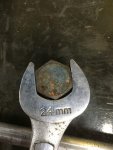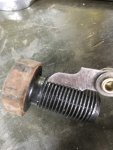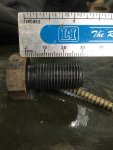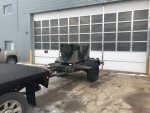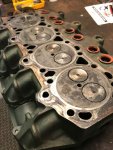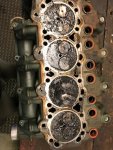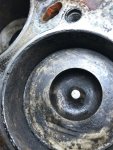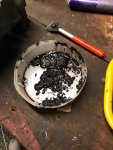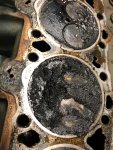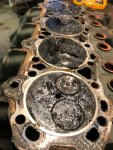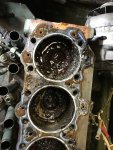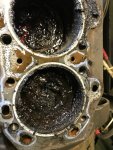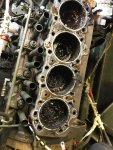You won't know until it doesn't move. Trust me its left hand threads so if your standing in the front of the pulley bolt, turn it clockwise. I think they put on with 220lbs of torque so it's going to be tight.
I once went to a unit that had some Brits working there. They call me, because the bolt had broken off, on not one generator, but two sets! They wanted to know if they should use heat, or maybe pound on the bolt first, before trying to remove it. And what kind of Lock tight was used on the bolt?
After I showed them that it was indeed a left hand bolt, they slunk off like politicians caught with their hands in the till. They had used a one inch drive socket set, and a camouflage pole for an extension. A fat guy stood on the end of it.
Below is a page from the -24 engine TM. Some people learn by READING. Some people learn by watching. Some people just have to piss on the electric fence.
ARMY TM 9-2815-253-24
AIR FORCE TO 38G1-93-2
MARINE CORPS TM 2815-24/3
3-4. DISASSEMBLY AND ASSEMBLY SEQUENCE FOR OVERHAUL.
The following paragraphs provide the sequence of disassembly and assembly for complete overhaul of the engine.
Step-by-step procedures can be found in remaining Sections of Chapter 3.
3-4.1. Disassembly. Every effort must be made to maintain engine in a clean condition and repair oil leaks. With a new
or overhauled engine parts settle during first few hours running and their tightness must be subsequently checked. When
engine is being disassembled all items must be identified, retained in their respective cylinder orientation, and all related
components must be treated similarly. The instructions given deal with individual components and it may be necessary
to remove other components prior to performing certain procedures.
a. Drain engine coolant, fuel, and lubrication systems. Refer to end item maintenance manual.
b. Remove fan drive belt. Refer to end item maintenance manual.
c. Remove battery charging alternator. Refer to end item maintenance manual.
d. Remove fan. Refer to end item maintenance manual.
e. Remove intake and exhaust manifolds. Refer to paragraphs 3-6 and 3-7.
f. Remove fuel pump to injector pipes. Refer to paragraph 3-18.
g. Remove injectors. Refer to paragraph 3-17.
h. Remove cylinder head covers. Refer to paragraph 3-25.
i. Remove valve rockers and pushrods. Refer to paragraph 3-26.
j. Remove water pump. Refer to paragraph 3-10.
k. Remove cylinder head. Refer to paragraph 3-27.
I. Lift out pushrod tubes, rubber seals, and washers. Refer to paragraph 3-27.
m. Remove remaining fuel pipes and fuel filter. Refer to paragraphs 3-15 and 3-16.
n. Remove dipstick and crankcase door. Refer to paragraph 3-20.
o. Remove oil pressure relief valve and the oil strainer. Refer to paragraph 3-21.
p. Remove connecting rod caps. Refer to paragraph 3-30.
q. Carefully remove carbon buildup from the top of cylinder bore.
r. Turn crankshaft until piston is at Top Dead Center (TDC).
s. Lift out pistons and connecting rods. Refer to paragraph 3-30.
t. Insert common screwdriver in flywheel to lock flywheel.
u. Remove crankshaft pulley; left hand thread. Remove screwdriver.
v. Move engine control to stop position.
w. Remove each fuel injection pump. Use care to retain shim pack with each pump. Refer to paragraph 3-13.
x. Remove gear end cover. Refer to paragraph 3-28.
y. Release speeder spring from governor lever assembly.
z. Remove governor lever assembly and governor rack. Refer to paragraph 3-23.


